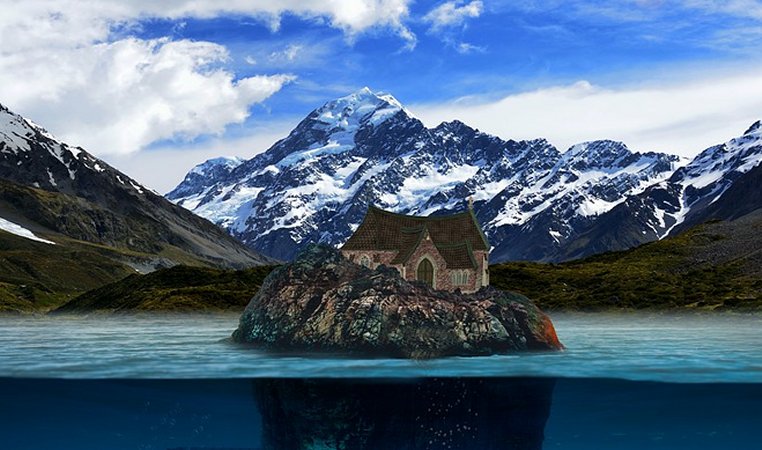Mystery Of Saint Brendan’s Island – Glimpses From An Alternate Reality, Fata Morgana Or A Submerged Land?
Ellen Lloyd - AncientPages.com - The legend of Saint Brendan's island has not died, but this intriguing place raises many questions. Does this mythical island exist? Why does it appear on ancient maps if it was merely a phantom island?
Why have so many observed the island, yet there is no visible trace of it?
What did Saint Brendan and his followers see? Credit: Public Domain
Why haven't modern scientists been able to locate St. Brendan's island? Could it have been an optical illusion caused by atmospheric conditions in the area at the time? Or was the sighting of the island caused by the Fata morgana effect? Could the tiny island be submerged, or did travelers glimpse an alternate reality?
In the middle of the sixth century, St. Brendan traveled in a small boat with fourteen monks. The first written records of his voyage did not appear until 300 years later, making it difficult to determine what happened.
However, when reading the Latin text Navigatio Sancti Brendani Abbatis ("Voyage of Saint Brendan the Abbot"), we know that Saint Brendan and his followers landed on a small island in 512 A.D. where they held a mass. The phantom island is supposedly located somewhere in the North Atlantic.
Tales of his remarkable journey captivated many during the Middle Ages, and soon many stepped forward claiming they had also seen the mysterious island.
Those stories could perhaps be dismissed, but intriguingly, St. Brendan's island appeared on many ancient maps, such as Martin Behaim's Erdapfel of 1492. Martin Behaim (1459 –1507) was a cartographer who served Joao II of Portugal as a navigational adviser. Behaim participated in a voyage to West Africa and produced the famous Erdapfel, the world's oldest surviving globe.
Why did Behaim add St. Brendan's island on his map if the place never existed? Was Behaim convinced that the island was natural?
There were beautiful birds, flowers and trees on the mythical island. Credit: Public Domain
Like Eden, St. Brendan's island was described as a beautiful place. Those who visited the island said once you set foot there, you couldn't see any darkness because the Sun never set. According to monk Barino, who also visited the island, this was a Paradise in the Atlantic. In his writings Navigatio Sancti Brendani Abbatis, Barino wrote this mythical and beautiful island blessed with warm weather. The island had delicious fruits, clean rivers, and beautiful birds sitting on trees.
Was the island merely a product of Barino's imagination, gossip, and dreams about the New World?
Many ancient Portuguese writers and explorers became interested in St. Brendan's island, and some even claimed to have spotted it before it quickly vanished again. Even Christopher Columbus is said to have believed in its existence.
In 1759 a Franciscan friar mentioned, but not identified by name, by Viera y Clavijo wrote to a friend: "I was most desirous to see the island of San Borondon and, finding myself in Alexero, La Palma, on May 3 at six of the morning, I saw and can swear to it on oath, that while having in plain view at the same time the island of El Hierro, I saw another island of the same color and appearance, and I made out through a telescope, much-wooded terrain in its central area.
Then I sent for the priest Antonio Jose Manrique, who had seen it twice previously, and upon arrival, he saw only a portion of it, for when he was watching, a cloud obscured the mountain. It was subsequently visible for another 90 minutes. We were seen by about forty spectators, but in the afternoon, when we returned to the same point, we could see nothing because of the heavy rain."
José de Viera y Clavijo (1731 – 1813), a Spanish historian, examined the question of Saint Brendan's Island. In his writing Noticias, Vol I, 1772, he wrote: "A few years ago while returning from the Americas, the captain of a ship of the Canary Fleet believed he saw La Palma appear and, having set his course for Tenerife based on his sighting, was astonished to find the real La Palma materialize in the distance next morning."
Map showing St Brendan's island. Credit: Clas Svahn: Naturfenomen, Public Domain
Viera adds that a similar entry is made in the diaries of Colonel Don Roberto de Rivas, who observed that his ship "having been close to the island of La Palma in the afternoon, and not arriving there until late the next day," the officer was forced to conclude that "the wind and current must have been extraordinarily unfavorable during the night."
Several expeditions were organized in the search for the island that monks, sailors, and captains frequently saw, but the sightings of Saint Brendan's island ceased more or less from the 19th century onwards.
Many myths and legends have been confirmed by modern science, but St. Brendan's island has never been discovered. It remains one of many legendary never, located lands that inspire countless writers around the world.
It is said that the legendary kingdom of Lyonesse disappeared underwater in a single night. Did St. Brendan Island meet the same catastrophic fate?
We can add that during the Middle Ages, writers mentioned several islands, kingdoms, and cities that had never been located. Prester John, for example, was said to be a wealthy Christian king and priest with a kingdom outside the Western European realm. With limited access to proper maps and many unexplored places, there was great confusion about where exactly his powerful kingdom was located, which has still never been found.
Many still discuss the legendary Norumberga, which remains an unsolved ancient mystery. Maybe there isn't anything to solve because it's possible this mythical place never existed. On the other hand, it's curious that Norumbega suddenly vanished from early maps.
Some scholars have suggested that Norumbega could be a lost Viking settlement.
Saint Brendan's Island may be a fictional place like the mythical places mentioned above. We cannot say why it appeared on ancient maps and what early explorers witnessed.
Updated on December 25, 2023
Written by Ellen Lloyd – AncientPages.com
Copyright © AncientPages.com All rights reserved. This material may not be published, broadcast, rewritten or redistributed in whole or part without the express written permission of AncientPages.com
More From Ancient Pages
-
 Igaluk – Powerful Eskimo Moon God That Directs Natural Phenomena
Featured Stories | Feb 13, 2019
Igaluk – Powerful Eskimo Moon God That Directs Natural Phenomena
Featured Stories | Feb 13, 2019 -
 Anundshög Burial Mound: One Of Sweden’s Richest And Largest Sacred Ancient Sites
Featured Stories | Aug 29, 2018
Anundshög Burial Mound: One Of Sweden’s Richest And Largest Sacred Ancient Sites
Featured Stories | Aug 29, 2018 -
 Crannogs – Artificial Islands In Scotland Are Older Than Stonehenge
Archaeology | Jun 17, 2019
Crannogs – Artificial Islands In Scotland Are Older Than Stonehenge
Archaeology | Jun 17, 2019 -
 Prince Wenceslaus Of Bohemia Murdered On Order Of His Own Brother
Featured Stories | Nov 19, 2019
Prince Wenceslaus Of Bohemia Murdered On Order Of His Own Brother
Featured Stories | Nov 19, 2019 -
 Egyptian ‘Golden Boy’ Mummy Was Protected By 49 Precious Amulets On His Journey To The Afterlife – CT Scans Reveal
Archaeology | Jan 24, 2023
Egyptian ‘Golden Boy’ Mummy Was Protected By 49 Precious Amulets On His Journey To The Afterlife – CT Scans Reveal
Archaeology | Jan 24, 2023 -
 People Who Carry Neanderthal Gene Variants Have Greater Pain Sensitivity
DNA | Oct 11, 2023
People Who Carry Neanderthal Gene Variants Have Greater Pain Sensitivity
DNA | Oct 11, 2023 -
 Mungo Man Finally To Rest In Peace After 42,000 Years – Reburial Approved After Federal Decision
News | Apr 8, 2022
Mungo Man Finally To Rest In Peace After 42,000 Years – Reburial Approved After Federal Decision
News | Apr 8, 2022 -
 Copper: First Metal Used By Ancient Man More Than 10,000 Years Ago
Ancient History Facts | Oct 25, 2016
Copper: First Metal Used By Ancient Man More Than 10,000 Years Ago
Ancient History Facts | Oct 25, 2016 -
 Men And Women Had Equal Access To Resources 6,000 Years Ago
Archaeology | Jun 17, 2024
Men And Women Had Equal Access To Resources 6,000 Years Ago
Archaeology | Jun 17, 2024 -
 Axis Mundi That Symbolizes Separation Of The Earth From The Heaven
Featured Stories | Jul 2, 2018
Axis Mundi That Symbolizes Separation Of The Earth From The Heaven
Featured Stories | Jul 2, 2018 -
 Who Were Persian ‘Sparabara’?
Featured Stories | Aug 28, 2017
Who Were Persian ‘Sparabara’?
Featured Stories | Aug 28, 2017 -
 Extraterrestrial Visit Recorded On Stone: They Came From The Stars
Featured Stories | May 4, 2014
Extraterrestrial Visit Recorded On Stone: They Came From The Stars
Featured Stories | May 4, 2014 -
 Strange Ancient Underwater Yellow Brick Road Discovered Of The Hawaiian Islands
News | May 11, 2022
Strange Ancient Underwater Yellow Brick Road Discovered Of The Hawaiian Islands
News | May 11, 2022 -
 Is This The World’s Oldest Joke?
Featured Stories | Feb 21, 2014
Is This The World’s Oldest Joke?
Featured Stories | Feb 21, 2014 -
 Number Nine: Sacred Symbol In Ancient Cultures
Ancient Symbols | Feb 14, 2017
Number Nine: Sacred Symbol In Ancient Cultures
Ancient Symbols | Feb 14, 2017 -
 Many Samurai Had Swords With Secret Crucifixes And Hidden Christian Symbols To Avoid Persecution
Ancient History Facts | Jan 10, 2017
Many Samurai Had Swords With Secret Crucifixes And Hidden Christian Symbols To Avoid Persecution
Ancient History Facts | Jan 10, 2017 -
 Early Humans Were Probably Driven To Extinction By Climate Change- Study Suggests
Civilizations | Oct 15, 2020
Early Humans Were Probably Driven To Extinction By Climate Change- Study Suggests
Civilizations | Oct 15, 2020 -
 Hel – Loki’s Terrible Daughter And Goddess Of The Land Of Dead
Featured Stories | Mar 26, 2018
Hel – Loki’s Terrible Daughter And Goddess Of The Land Of Dead
Featured Stories | Mar 26, 2018 -
 World’s Oldest Moon Map Carved Into Ireland’s 5,000 Year-Old Tomb At Knowth
Featured Stories | Jun 25, 2014
World’s Oldest Moon Map Carved Into Ireland’s 5,000 Year-Old Tomb At Knowth
Featured Stories | Jun 25, 2014 -
 Incredible Ancient Roman ‘Service Station’ With Hundreds Of Artifacts And Dozens Bodies Found In Hertfordshire, UK
Archaeology | May 12, 2022
Incredible Ancient Roman ‘Service Station’ With Hundreds Of Artifacts And Dozens Bodies Found In Hertfordshire, UK
Archaeology | May 12, 2022



